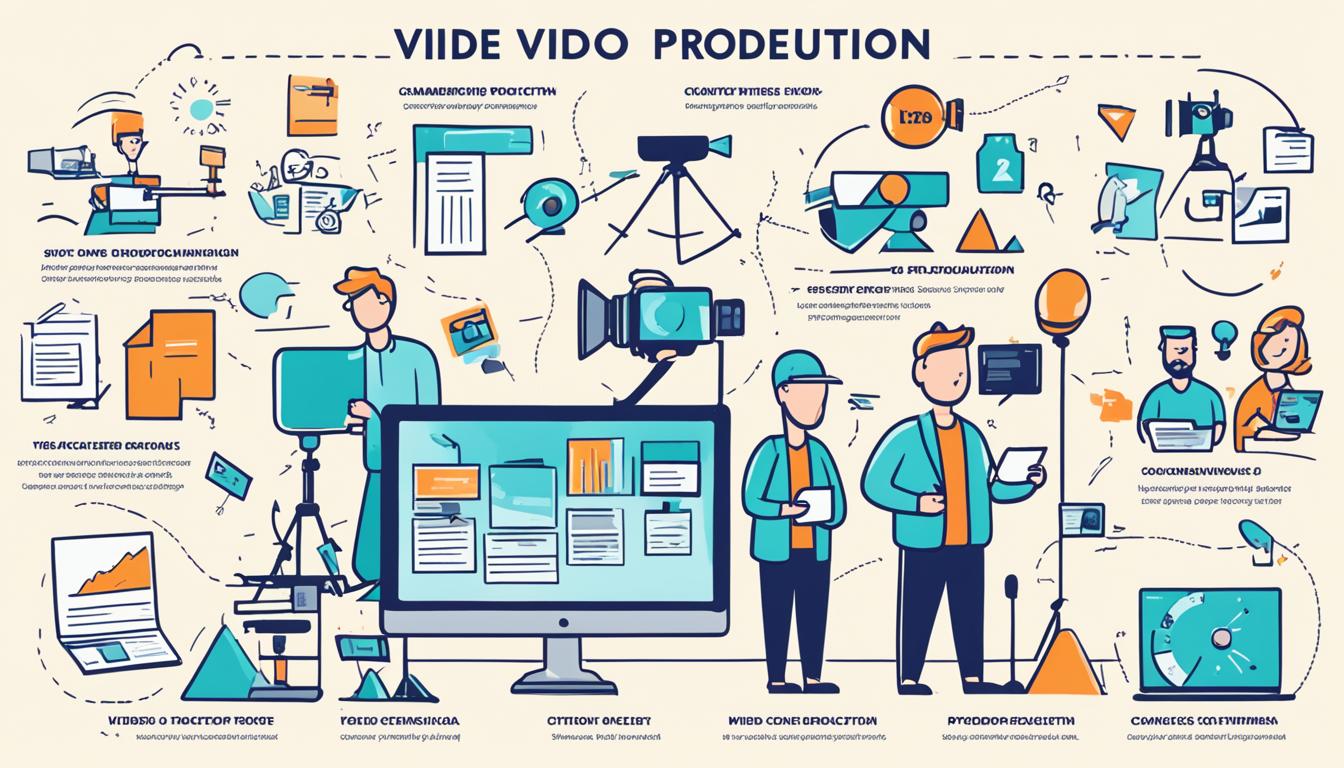Embarking on the journey of video production is no small feat. In an era where digital content rules, mastering the nuances of how to create a video production is becoming increasingly important for content creators and businesses alike. Creating professional videos involves a comprehensive process that branches out into pre-production, production, and post-production stages. These steps pave the way for visual storytelling that not only captivates but also communicates effectively with its intended audience.
Whether you’re a business owner in South Africa looking to expand your brand reach or a budding videographer aiming to produce your first short film, the process remains largely the same. An effective video production tutorial must transcend simply capturing footage; it involves strategic planning, robust scripting, scouting apt locations, and meticulous editing. And for those on a budget, fear not. DIY video production techniques are making it easier for anyone to produce quality content without breaking the bank. The road from concept to a polished video viewers can’t turn away from requires careful orchestration of these multiple elements.
Key Takeaways
- Understanding the video production process is key to creating content that engages and informs.
- Pre-production planning is critical for a smooth production phase and mitigates potential issues.
- A clear video strategy aligns the final product with your brand’s goals and target audience.
- In the DIY space, there are numerous resources available to guide you through making professional videos on a budget.
- Post-production, including editing and feedback, is where your video comes to life and is polished for distribution.
Pre-Production: Laying the Foundation for Successful Video Creation
In the domain of video production, the pre-production phase is where the groundwork is laid, setting the stage for creating video content that captivates and engages. By meticulously crafting a video production checklist, one can navigate through the essential video production steps with precision. The entire video production process is underpinned by strategic planning and creative forethought.
Defining Video Objectives and Strategy
The initial step in the pre-production phase is to crystallize the video’s purpose and outline a robust strategy that addresses target audiences and communication goals. This blueprint serves as a beacon throughout the production journey, ensuring that the end product resonates with viewers and aligns with brand objectives.
Scriptwriting and Storyboarding: Visualizing Your Concept
Scriptwriting lays down the narrative path, while storyboarding brings the script to life, providing a visual representation of each scene. These two elements work in tandem to construct a cohesive storyline, ensuring that every scene transitions smoothly to the next and that the messaging remains potent and on-brand.
Assembling Your Production Team and Equipment Needs
Finding the right mix of talent and technical resources is crucial. The production team should comprise professionals skilled in various aspects of video production, while the equipment list should cover all technical needs to produce high-fidelity video content.
Scouting Locations and Scheduling: The Logistics of Shooting
Scouting the perfect location is an art in itself, necessitating a keen eye for detail and an understanding of the logistical nuances. The scheduling matrix, an intricate weave of talent timelines and venue availability, forms the backbone of a well-orchestrated shoot.
Thorough preparation in the pre-production stage can mean the difference between a good video and a great one.
Below is a detailed video production checklist, which offers a clear outline of tasks to be completed during the pre-production phase:
| Task | Details | Responsibility |
|---|---|---|
| Objective Definition | Clarifying the video’s purpose and strategizing its implementation | Marketing Team |
| Scriptwriting | Developing the script to convey the intended message | Copywriter/Scriptwriter |
| Storyboarding | Creating visual frames to pre-visualize the video | Creative Director |
| Team Assembly | Gathering a crew with the right skill set for production | Production Manager |
| Equipment Procurement | Ensuring all necessary equipment is on hand | Technical Director |
| Location Scouting | Finding and securing suitable locations for filming | Location Manager |
| Scheduling | Coordinating the timing for all elements of the shoot | Production Coordinator |
Adhering to these guidelines ensures that the pre-production stage sets a solid foundation for a successful video project.
How do you create a video production?
When delving into the world of video production, the convergence of creativity and a systematic approach becomes the linchpin to crafting not just a video, but an impactful visual communication tool. It’s about intertwining a creative vision with a steadfast video production process that cements the foundation for what’s to come. A well-thought-out concept gets its lifeblood through diligent scriptwriting –- a process that not only lays down the narrative but also breathes life into the scenes that will unfold. The meticulous engines of pre-production then take the helm, ensuring everything from the precision of equipment to the budget and logistics is finely tuned as the canvas is prepared for the artist’s touch.
Wrapping Up: The Importance of a Solid Video Production Process
The scaffold for any successful video production is undisputedly its process—a tapestry woven with threads of planning, coordination, and keen attention to details. The end objective is to capture footage that speaks volumes, highlighting the story meant to resonate with audiences. Production is where the rubber meets the road, where every minute spent on perfecting the script and setting the stage leads to the tangible act of creating. Balancing creative desires with procedural efficiency allows for the delivery of content that does more than inform; it captivates and maintains the essence of the narrative’s original intent.
Reflecting on the Role of Review and Feedback
Once the scenes are shot and the actors’ voices grow silent, post-production takes the director’s baton. Here, in this editing alcove, the raw tapestry of visuals and sounds is intricately edited to not just tell a story but to elevate it. This stage holds a mirror up to the creators, reflecting the synthesized product of their efforts. It’s here that internal review and external feedback become invaluable, offering the scope for refinement and ensuring the final video aligns with the strategic vision. Each iteration, guided by expertise and responses, nudges the video closer to perfection.
Effective Distribution: Maximizing Your Video’s Reach
With the final cut ready, distribution strategy and optimization ensures the video’s narrative finds its way to the screens of the intended audience. An effective dissemination incorporates proper coding and optimization for seamless functionality across various devices and platforms, a staple in today’s multi-screen world. Utilizing video production tips such as leveraging social platforms and crafting engaging newsletters, helps magnify the video’s reach, ensuring it lands with impact. In conclusion, navigating through the tapestry of video production, from inception to viewer’s engagement, involves a recipe of originality, structured processes, and strategic distribution — a formula that, when followed, cultivates a potent means of storytelling, profoundly connecting with the South African audience.
FAQ
What are the essential steps in video production?
The essential steps in video production include pre-production, where you define your video objectives, strategy, script, storyboard, assemble your team and prepare the equipment. Production is the stage of capturing the footage, and post-production involves editing, sound mixing, and the final touches to create the polished video. Each step is integral to the process, ensuring that the final product is professional and resonates with your audience.
How does one start with pre-production for a video?
Pre-production starts with laying a strong foundation by defining your video objectives and strategy. This involves understanding your target audience, determining the message you want to convey, and how the video will fit into your overall marketing goals. Following this, you should write a script and create a storyboard to visualize your concept. Afterward, assemble your production team, determine your equipment needs, scout for locations, and meticulously plan your shoot schedule. This groundwork is critical to ensuring a smooth production phase.
Why is scriptwriting and storyboarding important in video production?
Scriptwriting and storyboarding are key because they serve as a blueprint for your video. Scriptwriting lays out the storyline, dialogue, and direction, while storyboarding provides a visual sequence of the video, helping everyone involved in the production to understand the visual narrative. These steps are essential for planning the flow of the video, ensuring all elements, such as transitions, camera angles, and shots, come together cohesively.
What should you consider when assembling your production team and equipment?
When assembling your production team and preparing your equipment, you need to consider the skill sets required for your project, such as a director, cameraperson, audio technician, and editor. Ensure that your team members are aligned with the vision of your project. As for equipment, consider the type of camera, lighting, audio equipment, and any additional gear like tripods or stabilizers needed to achieve your desired video quality. Balancing quality with your budget is key.
How critical is location scouting and scheduling in video production?
Location scouting and scheduling are vital aspects of the logistics of shooting. The right location can enhance the aesthetic value of your video and contribute to the storytelling. While scouting, consider factors such as natural light, sound quality, and space. Scheduling ensures that all team members and talent are available at the right times, and assists in acquiring proper permits and managing logistics, which contributes to the efficiency and smooth operation of the production phase.
Can you create a professional video by yourself?
Yes, with the right knowledge, equipment, and planning, DIY video production is possible. It’s important to understand the video production process, from pre-production to post-production, and to be prepared to wear multiple hats throughout the process. Learning about scriptwriting, storyboarding, filming, and editing are key skills for creating professional videos on your own. Having a clear vision and strategy for your video, as well as paying attention to details like lighting and sound, will help ensure a professional outcome.
What are the best tips for video production?
Some of the best video production tips include:
1) Plan each phase of production carefully.
2) Keep your content engaging and relevant to your target audience.
3) Invest in good lighting and sound for high-quality footage.
4) Pay attention to the composition and framing of each shot.
5) Edit your video for clarity, pacing, and impact.
6) Collect feedback and be prepared to make revisions.
7) Optimize your video for different platforms during the distribution phase to maximize reach.
How do you create a video production?
To create a video production, start with a comprehensive pre-production phase where you script, storyboard, and plan all aspects of the shoot. Then move to the production phase, where you capture the raw footage. Finally, proceed to post-production, where you edit the footage, add music, voiceover, effects, and any graphics to create the final video. Review and feedback are crucial before finalizing the video to ensure it meets your objectives. Remember to also plan for effective distribution and promotion strategies to reach your audience.
What is the significance of the video production process?
The video production process is significant because it provides a structured approach to creating content, ensuring that the end product is of high quality and fulfills its intended purpose. By adhering to a process, you can manage resources effectively, foster creativity within a structured environment, and develop content that is aligned with your strategy, engages your audience, and communicates your message effectively.
How important is review and feedback in the video production process?
Review and feedback are crucial in the video production process as they provide an opportunity to assess the video’s effectiveness and overall quality. Feedback from stakeholders, peers, or a test audience can highlight areas for improvement, ensure the video aligns with its objectives, and aids in refining the content before it’s distributed. This step is essential for enhancing the production’s value and ensuring its success.
What goes into effectively distributing a video?
Effective distribution involves more than just sharing your video. It includes encoding your video in the right formats for various platforms (such as social media, websites, and email campaigns), optimizing video SEO for better search visibility, and implementing a promotional strategy to increase reach. Paid advertising, social media promotion, and leveraging influencers or partnerships can also be part of an effective distribution plan.






